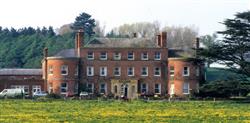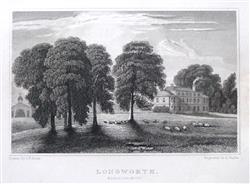Ann WALWYN 1749 - ???
Third child, second daughter of Richard WALWYN 1718 -1750 and Mary FLOYER 1721 - 1806 (from Whitbourne, Herefordshire)
Born 1749, Longworth, Lugwardine, Herefordshire
Died Mordiford, Herefordshire, England
Married 25 June 1767 at Whitbourne, to the Rev. Robert FOLEY 1736 - 1797
Four children were born to Robert FOLEY and Ann WALWYN
1) Robert FOLEY 1768 - 1794
2) Richard FOLEY 1772 - 1813
m.
Hannah MORSE 1769 - 1859
(Five children)
3) John FOLEY (Rev.) 1775 - 1847
m.
Martha Hickman HAYLEY 1772 - 1836
4) Thomas FOLEY 1776 - 1847
Longworth Hall, Lugwardine, Herefordshire
The Walwyn family owned the manor of Longford (later Longworth) from the 15th century, and their original mansion probably stood on the moated site at Old Longworth, where there was an ancient chapel. This first house, which does not seem to have been recorded, was replaced in the 18th century, probably for James Walwyn (c.1689-1766), who was MP for Hereford from 1723-27.
Longworth Hall: the entrance front in 1988. Image: Nicholas Kingsley.
The 18th century house is said by the Buildings of England to have been erected in about 1760, but it was called 'Hanoverian' by Charles Robinson in 1872 and must, I think, have been thirty or forty years earlier than that. This house does not seem to have been recorded either, before it was remodelled and given wings to the designs of Anthony Keck in c.1785-88 for James Walwyn (1744-1800), who was also MP for Hereford. Keck's house has a centre of six bays and two-and-a-half storeys, clamped between two-storey wings with generous three-windowed bows to front and rear. Bows like this were one of the design ideas which Keck used most frequently, and the plan of Longworth can be compared with that of Hill House, Rodborough (Glos), which is roughly contemporary. Bows were useful in that they made it easy to contrive interesting and varied room-shapes within, and if a room had interest from its form, it needed less in the way of expensive interior decoration, enabling Keck to please his clients by delivering elegance on a budget. Nonetheless, what decoration there was, was done to a good standard. Keck was a joiner by original training, and he ensured that his houses had mahogany doors of excellent quality and good staircases. The staircase at Longworth, which rises at the rear of the entrance hall, seems to be a survivor from the earlier 18th century house, and has barley-twist balusters. The house also has some good plasterwork in Keck's best neo-classical style, including the tripartite door and window frame of the entrance hall.
Longworth Hall: view of the park in c.1820, with the old chapel on the left.
The grounds of the house were noted in the 19th century for their extensive timber and for the fine pleasure gardens laid out by Robert Phillipps within the park in the 19th century. West of the house is a late 18th century quadrangular stable block with a pedimental gable above its entrance arch, perhaps also by Keck. The estate has several lodges: a pair north-east of the house, thought to date from about 1825, and a Victorian one of c.1860, with patterned brickwork, stone bands and rather unexpectedly round-arched windows, which could be by E.W. Pugin.
On the death of Robert Biddulph Phillipps in 1864, he left the estate (but not his personal fortune) to his wife's nephew, William Henry Barneby (1843-1914), who came of age in that year and came into possession of a legacy left to him by his father, who had died young. Barneby seems to have used the legacy to buy the Bredenbury Court estate, and he never lived at Longworth. It was instead let to tenants or used by other members of the family throughout his long life. His son, Richard Hicks Barneby (1875-1923) apparently moved in after his father's death, but when he died in 1923 after a lingering illness, the estate was sold to Sir John Fox Dillon (d. 1925), 8th bt., whose widow remained at Longworth until her death in 1943.
The house was then sold for use as a hotel, which it remains today.
Descent: Richard Walwyn of Ross-on-Wye; to younger son, James Walwyn (d. 1705); to son, James Walwyn (c.1689-1766); to grandson, James Walwyn MP (1744-1800); to son, Maj. James Walwyn (b. 1768), who sold 1805 to his uncle, Robert Phillipps (1749-1822); to son, Robert Biddulph Phillipps (d. 1864); to nephew, William Henry Barneby (1843-1914), who let to Edward Smalley Hutchinson (fl. 1872); to son, Richard Hicks Barneby (1875-1923); sold 1923 to Sir John Fox Dillon (d. 1925), 8th bt.; to widow, Lady Dillon (d. 1943); sold after her death for use as a hotel.
Source = Landed families of Britain and Ireland by Nicholas Kingsley. https://landedfamilies.blogspot.com/2019/11/
See also Hellens, Much Marcle

